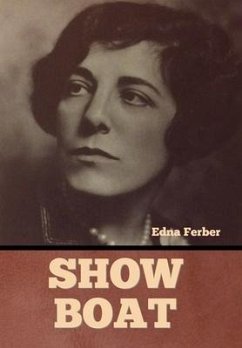Show Boat is a 1926 novel by American author and dramatist Edna Ferber. It chronicles the lives of three generations of performers on the Cotton Blossom, a floating theater on a steamboat that travels between small towns along the banks of the Mississippi River, from the 1880s to the 1920s. The story moves from the Reconstruction Era riverboat to Gilded Age Chicago to Roaring Twenties New York, and finally returns to the Mississippi River. Show Boat was adapted as a Broadway musical in 1927 by Jerome Kern and Oscar Hammerstein II. Three films followed: a 1929 version that depended partly on the musical, and two full adaptations of the musical in 1936 and 1951. In August 1924, Edna Ferber watched as the opening performance of her play Minick (co-written with George S. Kaufman) was disrupted by an invasion of bats that had been nesting undetected in the chandeliers and dome of the playhouse. Alarmed theatergoers scurried for the exits. As the crew recovered from this debacle, Winthrop Ames, the show's producer, jokingly remarked: "Next time... we won't bother with tryouts. We'll all charter a show boat and we'll just drift down the rivers, playing the towns as we come to them." Show boats were floating theaters that traveled along rivers of the United States from the 1870s to the 1930s. The performers lived aboard the vessels. With song, dance, and dramatic productions, show boats provided entertainment for small riverside towns that were otherwise quite isolated. Ferber, who had never heard of show boats, was immediately intrigued: "Here, I thought, was one of the most melodramatic and gorgeous bits of Americana that had ever come my way. It was not only the theater - it was the theater plus the glamour of the wandering drifting life, the drama of the river towns, the mystery and terror of the Mississippi itself... I spent a year hunting down every available scrap of show-boat material; reading, interviewing, taking notes and making outlines." In 1925, Ferber traveled to Bath, North Carolina, and spent four days aboard one of the few remaining show boats in the country, the James Adams Floating Theatre, which plied the Pamlico River and Great Dismal Swamp Canal. An account of Ferber's visit to Bath is posted at NCHistoricSites.org. The material she gathered, especially the reminiscences of Charles Hunter, the director and chief actor, provided her with "a treasure-trove of show-boat material, human, touching, true." Ferber spent the next year in France and New York writing the novel, and published it in the summer of 1926. The mix of romance, realistic depiction of racial issues, and nostalgia for a vanishing American past was an immediate hit with the public, and the novel was number one on the bestseller lists for twelve weeks. The critical reception was more cautious but still positive. In his New York Times review, Louis Kronenberger wrote: "With Show Boat, Miss Ferber establishes herself not as one of those who are inaugurating first-rate literature, but as one of those who are reviving first-rate story-telling. This is little else but an irresistible story; but that, surely, is enough." By the time the James Adams Floating Theatre was destroyed by fire in 1941, the era of show boats had ended, supplanted by the motion pictures theater. Writing for the Jewish Women's Archive, Allison Abrams described Show Boat as "problematic" on race, claiming that the novel "maintains a romanticized and subordinate image of Black Americans", uses "dehumanizing and animalistic terms" for Black people, perpetuates racial stereotypes about Black men, and "lumps Black Americans in the fold of the working class which is reflective of a perception of race as an economic class...and less so a social reality." (wikipedia.org)
Hinweis: Dieser Artikel kann nur an eine deutsche Lieferadresse ausgeliefert werden.
Hinweis: Dieser Artikel kann nur an eine deutsche Lieferadresse ausgeliefert werden.








